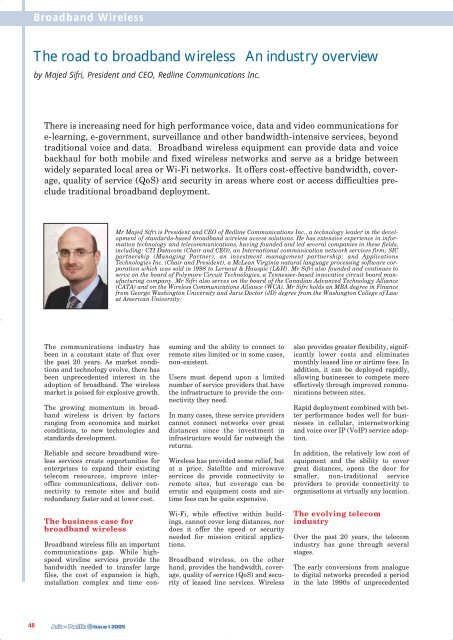Contents - Connect-World
Contents - Connect-World
Contents - Connect-World
You also want an ePaper? Increase the reach of your titles
YUMPU automatically turns print PDFs into web optimized ePapers that Google loves.
Broadband Wireless<br />
The road to broadband wirelessAn industry overview<br />
by Majed Sifri, President and CEO, Redline Communications Inc.<br />
There is increasing need for high performance voice, data and video communications for<br />
e-learning, e-government, surveillance and other bandwidth-intensive services, beyond<br />
traditional voice and data. Broadband wireless equipment can provide data and voice<br />
backhaul for both mobile and fixed wireless networks and serve as a bridge between<br />
widely separated local area or Wi-Fi networks. It offers cost-effective bandwidth, coverage,<br />
quality of service (QoS) and security in areas where cost or access difficulties preclude<br />
traditional broadband deployment.<br />
Mr Majed Sifri is President and CEO of Redline Communications Inc., a technology leader in the development<br />
of standards-based broadband wireless access solutions. He has extensive experience in information<br />
technology and telecommunications, having founded and led several companies in these fields,<br />
including: CTI Datacom (Chair and CEO), an International communication network services firm; SIC<br />
partnership (Managing Partner), an investment management partnership; and Applications<br />
Technologies Inc. (Chair and President), a McLean Virginia natural language processing software corporation<br />
which was sold in 1998 to Lernout & Hauspie (L&H). Mr Sifri also founded and continues to<br />
serve on the board of Polymore Circuit Technologies, a Tennessee-based innovative circuit board manufacturing<br />
company. Mr Sifri also serves on the board of the Canadian Advanced Technology Alliance<br />
(CATA) and on the Wireless Communications Alliance (WCA). Mr Sifri holds an MBA degree in Finance<br />
from George Washington University and Juris Doctor (JD) degree from the Washington College of Law<br />
at American University.<br />
The communications industry has<br />
been in a constant state of flux over<br />
the past 20 years. As market conditions<br />
and technology evolve, there has<br />
been unprecedented interest in the<br />
adoption of broadband. The wireless<br />
market is poised for explosive growth.<br />
The growing momentum in broadband<br />
wireless is driven by factors<br />
ranging from economics and market<br />
conditions, to new technologies and<br />
standards development.<br />
Reliable and secure broadband wireless<br />
services create opportunities for<br />
enterprises to expand their existing<br />
telecom resources, improve interoffice<br />
communications, deliver connectivity<br />
to remote sites and build<br />
redundancy faster and at lower cost.<br />
The business case for<br />
broadband wireless<br />
Broadband wireless fills an important<br />
communications gap. While highspeed<br />
wireline services provide the<br />
bandwidth needed to transfer large<br />
files, the cost of expansion is high,<br />
installation complex and time consuming<br />
and the ability to connect to<br />
remote sites limited or in some cases,<br />
non-existent.<br />
Users must depend upon a limited<br />
number of service providers that have<br />
the infrastructure to provide the connectivity<br />
they need.<br />
In many cases, these service providers<br />
cannot connect networks over great<br />
distances since the investment in<br />
infrastructure would far outweigh the<br />
returns.<br />
Wireless has provided some relief, but<br />
at a price. Satellite and microwave<br />
services do provide connectivity to<br />
remote sites, but coverage can be<br />
erratic and equipment costs and airtime<br />
fees can be quite expensive.<br />
Wi-Fi, while effective within buildings,<br />
cannot cover long distances, nor<br />
does it offer the speed or security<br />
needed for mission critical applications.<br />
Broadband wireless, on the other<br />
hand, provides the bandwidth, coverage,<br />
quality of service (QoS) and security<br />
of leased line services. Wireless<br />
also provides greater flexibility, significantly<br />
lower costs and eliminates<br />
monthly leased line or airtime fees. In<br />
addition, it can be deployed rapidly,<br />
allowing businesses to compete more<br />
effectively through improved communications<br />
between sites.<br />
Rapid deployment combined with better<br />
performance bodes well for businesses<br />
in cellular, internetworking<br />
and voice over IP (VoIP) service adoption.<br />
In addition, the relatively low cost of<br />
equipment and the ability to cover<br />
great distances, opens the door for<br />
smaller, non-traditional service<br />
providers to provide connectivity to<br />
organisations at virtually any location.<br />
The evolving telecom<br />
industry<br />
Over the past 20 years, the telecom<br />
industry has gone through several<br />
stages.<br />
The early conversions from analogue<br />
to digital networks preceded a period<br />
in the late 1990s of unprecedented<br />
48
















